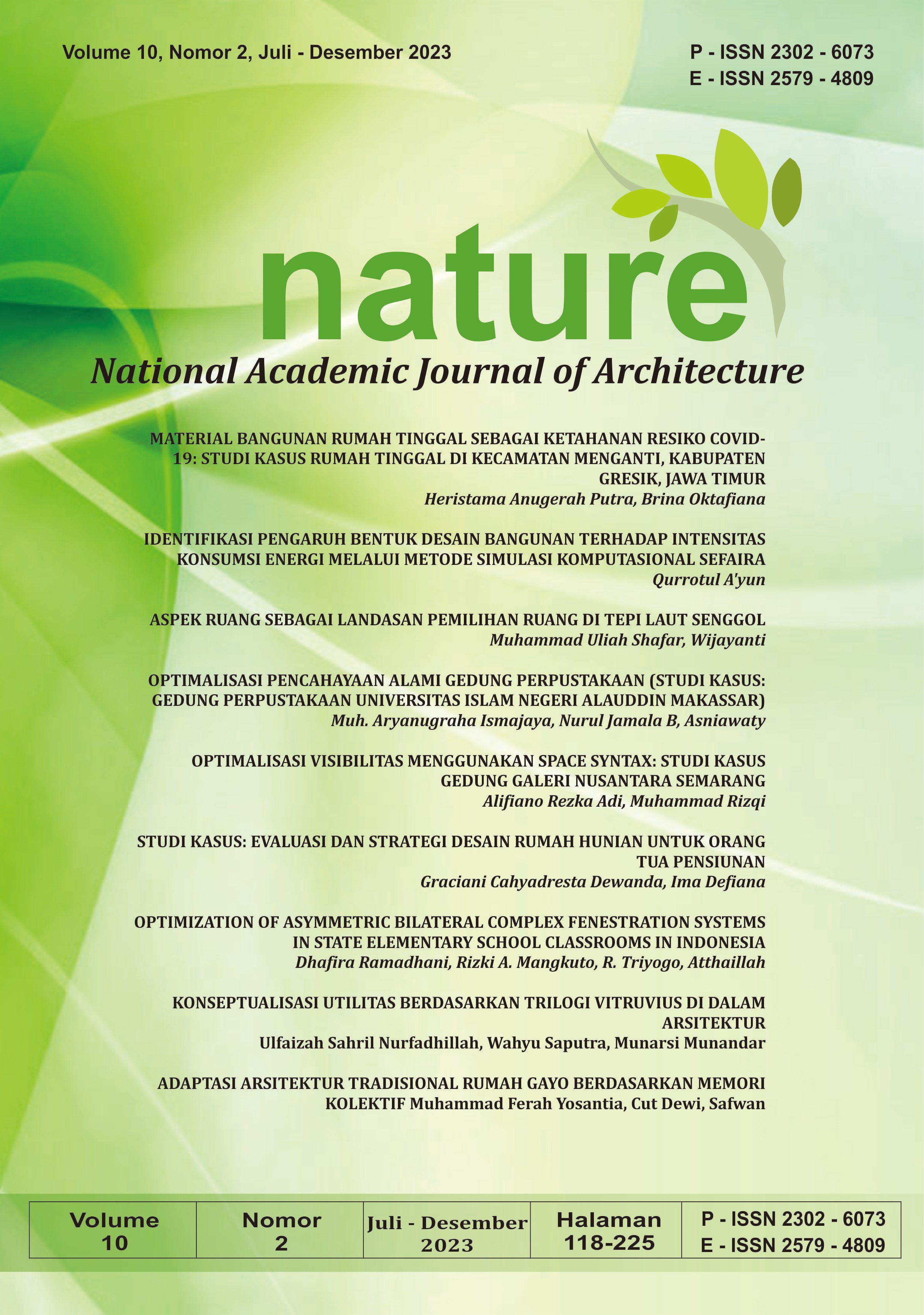OPTIMALISASI PENCAHAYAAN ALAMI GEDUNG PERPUSTAKAAN (STUDI KASUS: GEDUNG PERPUSTAKAAN UNIVERSITAS ISLAM NEGERI ALAUDDIN MAKASSAR)
Abstract
This research aims to optimize natural lighting in the Alauddin Makassar State Islamic University Library building by enhancing the distribution of natural light. The study employs a quantitative method involving direct measurement of natural lighting using a lux meter on-site and the dissemination of questionnaires among library visitors. Field measurement data is processed using MS Office Excel to assess the lighting conditions. Additionally, the application of Autodesk Ecotect with the Desktop Radiance plugin is utilized to simulate field measurement outcomes. To optimize natural lighting, simulations are conducted using six different models of light shelves. The simulation results indicate that employing a light shelf positioned centrally with an external angled surface proves most effective in maximizing natural light entry into the building. On the second floor, a centrally positioned light shelf with a 15° angle on each outer window opening yields the highest R2 value of 0.94. Meanwhile, on the third floor, using a centrally positioned light shelf with a 30° angle on the north side and 15° on the south side of the window achieves the highest R2 value of 0.85.
Downloads
References
Adi, A.R. (2019) ‘Optimalisasi Pencahayaan Alami Pada Ruang Perpustakaan Universitas Islam Negeri Walisongo Semarang’. Available at: https://ojs.uajy.ac.id/index.php/komposisi/article/view/2780/1629.
Amanda, B. (2019) ‘The Role of Libraries in Advancing Knowledge: A Literature Review’, Library Quarterly, 89(3), pp. 301–318.
Badan Standarisasi Nasional (2001) SNI 03-2396-2001 Tata Cara Perancangan Sistem Pencahayaan Alami pada Bangunan Gedung. Jakarta: BSN.
David, S. (2014) ‘The Importance of Lighting in Architectural Design’, Journal of Architectural Engineering, 10, pp. 145–158.
Emily, A. (2005) ‘The Emotional Impact of Lighting in Architectural Spaces’, Journal of Architectural and Planning Research, 22(3), pp. 217–230.
Jessica, L. (2013) ‘Quantitative Analysis of Daylighting Performance in Architectural Spaces: A Case Study using Autodesk Ecotect with Desktop Radiance Plugin’, Building and Environment, 5, pp. 158–167.
John, S. (2014) ‘Energy Saving in Building Lighting Systems through Occupancy Sensing Technology: A Review’, Energy and Buildings, 72, pp. 250–259.
Kurniasih, S. and Saputra, O. (2019) ‘Evaluasi Tingkat Pencahayaan Ruang Baca Pada Perpustakaan Universitas Budi Luhur, Jakarta’, Jurnal Arsitektur ARCADE, 3(1), p. 73. Available at: https://doi.org/10.31848/arcade.v3i1.136.
Manurung, P. (2012) Pencahayaan Alami dalam Arsitektur. Edited by F.S. Suyantoro. Yogyakarta: Penerbit ANDI.
Maria, G. (2018) ‘Analysis of Data for Generating Alternative Solutions for Library Building Lighting Systems’, Journal of Building Performance, 12(2), pp. 145–158.
Michael, T. (2010) ‘The Inherent Connection between Humans and Natural Light in Architecture’, Journal of Environmental Psychology, 30, pp. 103–116.
Roy, M., Hamzah, B. and Jamala B, N. (2018) ‘Analisis Pencahayaan Alami Ruang Perpustakaan Fakultas Teknik Gowa Universitas Hasanuddin’, Jurnal Lingkungan Binaan Indonesia, 7(2), pp. 111–115. Available at: https://doi.org/10.32315/jlbi.7.2.111.
Sarah, J. (2005) ‘The Role of Lighting in Shaping Architectural Experience and Understanding’, Journal of Environmental Psychology, 25(4), pp. 457–473.
Copyright (c) 2023 Muh. Aryanugraha Ismajaya, Nurul Jamala B, Asniawaty

This work is licensed under a Creative Commons Attribution-ShareAlike 4.0 International License.
By submitting your manuscript to our journal, you are following Copyright and License











